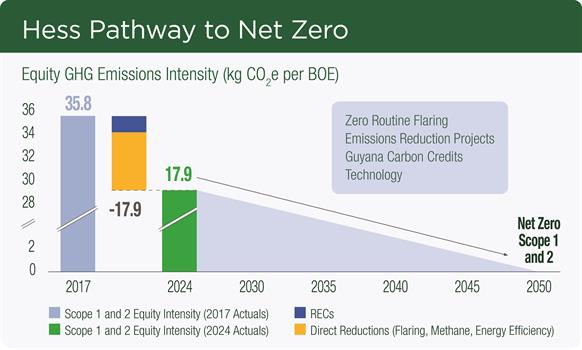Hess’ Climate Change Position
We support the Paris Agreement’s aim to limit global average temperature rise to well below 2°C and have made a commitment to achieve net zero Scope 1 and 2 greenhouse gas (GHG) emissions on an equity basis by 2050. We believe climate risks can and should be addressed while at the same time meeting the growing demand for affordable, reliable and secure energy, which is essential to ensure a just and orderly energy transition that aligns with the United Nations Sustainable Development Goals. Governments, businesses and civil society must work together on cost effective policies to meet this dual challenge, and we support transparent carbon pricing as an economically efficient method to encourage the investments needed to accelerate decarbonization across all sectors of the economy while keeping energy affordable and secure. We review the climate positions of our major advocacy organizations on an ongoing basis, and in the event that those positions appear misaligned or become misaligned with Hess’ positions, we will share our viewpoint in an attempt to more closely align their position with ours.
Our company’s strategy is focused on high return resource growth, low cost of supply and industry leading cash flow while maintaining leadership in sustainability. Our climate strategy is closely aligned with the recommendations of the Task Force on Climate-Related Financial Disclosures (TCFD) and its implementation is led by senior members of our leadership team with oversight by our Board of Directors. Our Low Carbon Transition Framework details how we are addressing climate related risks, opportunities and actions in the areas of governance, strategy, risk management and metrics and targets consistent with the TCFD’s October 2021 guidance.
Our Board of Directors is climate change literate, and we periodically bring in subject matter experts to advise our Board on climate and other sustainability issues to be considered in the development of company strategies and policies. Our Board’s Environmental, Health and Safety (EHS) Committee, composed of independent directors, has a mandate to identify, evaluate, monitor and report to the full Board on climate change issues, trends, risks and opportunities. The EHS Committee is actively engaged in overseeing Hess’ sustainability practices and works alongside senior management to evaluate climate change risks and global scenarios in making strategic decisions. For example, the committee provided oversight during development of our plan to achieve net zero Scope 1 and 2 emissions on an equity basis by 2050. Furthermore, the Board’s Compensation and Management Development Committee has linked executive compensation to advancing the company’s EHS and climate change goals.
Our business planning includes actions we will undertake to continue reducing our carbon footprint consistent with the Paris Agreement’s aim to limit global average temperature rise to well below 2°C. Our Board and senior leadership have set aggressive interim GHG reduction targets to drive these actions and to support our goal to reach net zero emissions. In addition to our ongoing emissions reduction efforts, and as an important part of our net zero commitment, Hess agreed to purchase high quality, independently verified REDD+ (reducing emissions from deforestation and degradation) carbon credits for a minimum of $750 million between 2022 and 2032 directly from the government of Guyana. Protecting the world’s forests and the important role they play as natural carbon sinks is foundational to the Paris Agreement’s aim of limiting the global average temperature rise to well below 2°C and was one of the major commitments made at the 26th United Nations Climate Change Conference of the Parties climate summit.
We offset 100% of the indirect Scope 2 emissions from our purchased electricity through the purchase of renewable energy certificates, with most of our current certificates coming directly from the electric cooperative which provides our power in basin, and we continue to look for further electrification opportunities to reduce our emissions.
As part of our sustainability commitment, we seek to fund innovation with the potential to mitigate societal emissions, including the Salk Institute’s Harnessing Plants Initiative, which aims to develop plants with larger root systems that are capable of absorbing and storing potentially billions of tons of carbon per year from the atmosphere.
We account for the cost of carbon in significant capital investment decisions. We conduct scenario planning that includes scenarios developed by the International Energy Agency (IEA) to test the resilience of Hess’ portfolio against a range of environmental policies and market conditions in a lower carbon economy and publish the results of our analyses. We also consider potential physical risks associated with climate change, such as heat stress, flooding, increased severity of storms and drought, for new projects and existing operations.
Hess’ strategic priorities – to grow our resource base, deliver a low cost of supply and generate industry leading cash flow growth while maintaining our industry leadership in environmental, social and governance performance and disclosure – are aligned with the energy transition needed to achieve the IEA’s APS.
Strategy and Targets
Hess executives have led the development and implementation of our Low Carbon Transition Framework, including our plan to achieve net zero Scope 1 and 2 GHG emissions on an equity basis by 2050. We are currently on track to surpass our 2025 targets for GHG emissions intensity, methane emissions intensity and zero routine flaring. Please see Emissions and Flaring Performance for details.
We expect that our commitments to reduce GHG and methane emissions intensity, eliminate routine flaring and purchase renewable energy will help us mitigate a significant portion of our current Scope 1 and 2 emissions profile. We also continue to examine additional opportunities to address our GHG emissions. These include increased energy efficiency from electrification of our operations, carbon capture and sequestration and deployment of advanced technologies that are not currently commercially viable or are still in development, in combination with the use of carbon credits – including those we have agreed to purchase from the government of Guyana.
